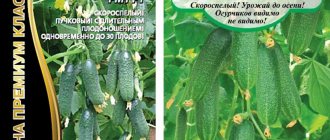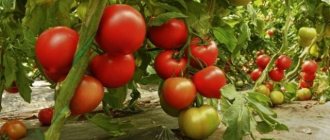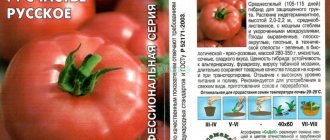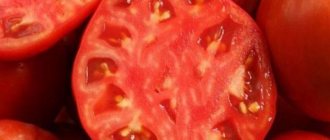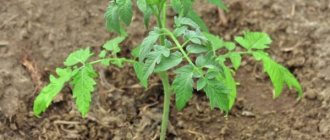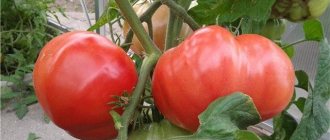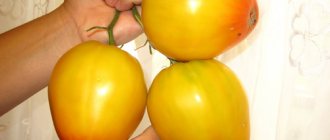Cucumber variety Zozulya F1: description of the variety, photos, reviews, planting and care, growing a hybrid
Cucumbers, along with tomatoes, are the most popular vegetable crops, which are grown in almost all summer cottages. Today, more than 2,500 varieties and hybrids of cucumbers are known, and making a choice in favor of specific varieties is sometimes difficult even for experienced vegetable growers.
This article will talk about the hybrid cucumber Zozulya f1, its main advantages, productivity, diseases and pests, as well as the nuances of growing this vegetable crop.
The content of the article:
1. History of creation 2. Characteristics and description 3. Productivity of the Zozulya cucumber variety 4. Diseases and pests 5. Advantages and disadvantages 6. Planting seedlings 7. Further care of Zozulya cucumbers 8. How to feed plants 9. Reviews of the Zozulya cucumber
History of the variety's creation
Cucumber Zozulya F1 has been known to Russian vegetable growers for more than 40 years
- he was bred by Russian breeders Kudryashov, Mukhin and Skachko, working at the vegetable station named after. V. I. Edelshtein. When breeding the Zozulya cucumber, varieties of this vegetable crop with different genetic codes were crossed.
The Zozulya variety was submitted for inclusion in the State Register at the end of the third quarter of the last century and after tests in 1977 it was entered into the State Register of the USSR. The variety is recommended for cultivation in greenhouses in almost all regions of Russia and the Union republics (currently the CIS countries).
Cucumber Zozulya F1 - photo
Features of growing in a greenhouse
Growing cucumbers in a greenhouse has a huge advantage, because if the greenhouse is properly equipped, you can get a harvest all year round. The Zozulya F1 variety is self-pollinating, which means it is ideal for these purposes. Near each bush there should be, for example, a metal rod to which the lashes of the bush will be tied. The height of such rods should be at least 1.5 m. You can tie cucumbers by stretching ropes (jute, twine) vertically from each bush to the top beam.
Photo: © howtogrowfoods.com
A properly equipped greenhouse makes it possible to create the necessary microclimate, which, in turn, guarantees year-round fruiting of the crop.
Cucumber Zozulya: characteristics and description of the variety
The cucumber hybrid Zozulya belongs to the parthenocarpic type
Therefore, its flowers pollinate themselves, without requiring the presence of bees or the efforts of vegetable growers. A large number of ovaries are formed on the lashes of this plant, the number of which does not depend on changes in weather conditions and does not require the presence of pollinating insects.
On a note!
Zozulya cucumbers are an early ripening variety - approximately 1.5 months pass from the moment the seed material germinates to the first harvest.
And the usual ripening period for most other early-ripening cucumbers is at least 2 months. Thanks to such a rapid ripening period, Zozulya cucumbers are actively grown by those vegetable growers who grow early varieties of vegetable crops for further sale, as well as in regions with a short warm summer season (in the Urals, Siberia, the middle zone or the Leningrad region).
This hybrid has medium-length, well-leafed lashes. When grown in greenhouse conditions, the Zozulya cucumber is tied to trellises.
In this case, it is easier to care for the bushes and also to collect ripening fruits. The flowers are collected in inflorescences of 5-9 pieces each. As a result, cucumbers ripen simultaneously in large quantities.
Ripe cucumbers of the Zozulya variety are elongated, cylindrical, approximately equal and even. The length of a ripe Zozulya cucumber can reach 16-25 cm, and its weight can range from 165 to 200 g.
The skin of the fruit is dense, crispy, on its light emerald surface longitudinal stripes of a lighter shade are clearly visible, as well as rare small tubercles with dark spikes.
The pulp of Zozulya greens is compact, elastic, with a characteristic crunch and a sweet taste, without bitterness.
Photo of Zozulya cucumber
Collected Zozulya cucumbers are distinguished by their versatility - they are used for preparing salads and snacks, canning, and can also be pickled. Even after heat treatment, the cucumbers remain crispy and elastic.
The harvested crop tolerates transportation well over long distances, without losing its taste and presentation, and has good shelf life.
Features of agricultural technology
To grow a vegetable, a gardener can choose a seedling or non-seedling method. Briefly about the cultivation technique:
- the time for sowing seeds for seedlings is calculated in such a way that when moving to the garden bed, the age of the sprouts reaches 20–25 days;
- Cucumbers are sown directly into the ground when the soil warms up above 24 degrees;
- up to 3 bushes are placed per 1 m²;
- Plant feeding is carried out every 10 days;
- Before the formation of 6 leaves, all shoots and flowers are removed from the stem;
- the crop is tied to a trellis;
- Fruits should be collected every 2 to 3 days.
Advice. In order to prevent the soil under the bushes from drying out, it is necessary to resort to mulching. This measure will also reduce weed growth activity.
Sowing seeds for seedlings | Planting seedlings in a greenhouse/greenhouse | Planting OG seedlings | Stepsoning | Harvesting |
| last days of April – beginning of May | The end of May | 3rd decade of May – first days of June | up to 6 leaves | June - September |
| *dates are indicated for central Russia | ||||
Diseases and pests
The cucumber hybrid Zozulya is highly resistant to most diseases that affect other varieties of this vegetable crop.
Zozulya has the highest resistance to the following diseases:
- root rot;
- olive spot;
- cucumber mosaic virus.
All these diseases most often appear in crops growing indoors, which is why this hybrid is so valuable, which grows well in a greenhouse and is not affected by all of the above diseases.
Cucumber varieties!
Meringue F1 Cucumber Connie Cucumber Aragats
Description of Zozulenok cucumbers
According to the official description, the yield of the variety is 15.5 kg/m². Zozulenok f1 bears fruit together, within 3-4 months. Medium-sized bushes, not too branchy. The leaves are large, dark green, in the shape of a heart pointed towards the bottom.
Cucumber fruits are large, up to 22 cm long, at least 3.5 cm in diameter. Each cucumber weighs approximately 200 g.
Zozulenka is highly immune to common diseases and tolerates storage and transportation well. The variety is classified as a salad variety, but young cucumbers are great for twisting.
Advantages and disadvantages
The main advantages of the Zozulya cucumber include:
- large tasty greens;
- self-pollinating flowers;
- the presence of pollinating insects is not required for the formation of ovaries;
- high productivity;
- early ripening of greens;
- the possibility of growing almost throughout the entire territory of Russia;
- high resistance to most diseases characteristic of other cucumber varieties;
- the versatility of the collected fruits.
Zozulya cucumber has practically no disadvantages. It should only be noted that this cucumber is a hybrid, so you cannot collect seeds for further planting - they do not have parental characteristics.
Cucumber Zozulya: planting seedlings
You need to buy seeds of the Zozulya hybrid in specialized stores, choosing seed from well-known agricultural companies - seed producers. In this case, you can be sure that the planting material will be almost 100% viable, having undergone pre-sowing treatment. As a result, such Zozulya cucumber seeds will need to be soaked before sowing for germination, and then planted in a permanent place in the greenhouse.
In order to get the harvest of these cucumbers early, many vegetable growers pre-grow Zozulya cucumber seedlings at home.
Soil for planting can be purchased at a specialized store, or you can prepare a nutrient substrate yourself. In this case, garden soil, river sand and high-moor peat are mixed in a ratio of 1:1:1. Before use, the soil mixture prepared at home should be calcined in the oven for half an hour at a temperature of about 180 degrees, then cooled. And only after this can the soil be laid out in pots.
Growing seedlings
In order to obtain high-quality planting material, certain conditions must be met (proper seed preparation, their calibration, temperature conditions, and more). Healthy seedlings are the key to a good harvest of Zozulya cucumbers.
Seed preparation
It is known that not all seeds are capable of sprouting. An important activity at this stage is calibration, thanks to which you can sort empty seeds from viable ones. To do this, they are placed in a saline solution (1 teaspoon of ordinary table salt per 1 liter of boiled water), after five minutes the floating seeds are removed, and those that have settled to the bottom are taken out for further soaking. Such manipulations have another positive effect - disinfection of seed material.
Photo: © jerry-coleby-williams.net
The second stage is soaking. It will help the seeds to hatch faster and easier. You can often read in recommendations that you should use gauze for these purposes. In fact, in gauze, delicate roots can get caught in the microcells of the tissue, and this can damage their integrity. For example, a cellulose napkin or cotton cloth is perfect. The napkin should be laid out on a small saucer, then the seeds should be placed on one part of it, and the other should be covered, moistened well with warm water and left in a place with a temperature of at least 25°C. Within two or three days the seeds will hatch.
Further care for Zozulya cucumbers
Seedlings of Zozulya cucumbers are transplanted into previously prepared beds in a greenhouse or open ground, which are pre-fertilized with humus and mineral fertilizers containing phosphorus and potassium.
No more than 4 cucumber plants should be planted on each square of area.
After transplanting the cucumber bushes to a permanent place in the greenhouse, they should be watered daily until the plants acclimatize to the new place. In the future, it is recommended to water growing cucumbers every other day. If the weather is hot and dry, then the amount of watering is increased.
After watering, be sure to loosen around the bushes, trying not to damage their roots.
. Loosening allows you to remove the crust on the soil surface, which prevents moisture and air from entering the soil. At the same time as this procedure, weeds should be removed, especially when the cucumber bushes are still small.
When the cucumber vines become large enough, they are tied to supports. In greenhouse conditions, it is better to use trellises as supports for Zozulya cucumbers.
Possible diseases and how to combat them
Cucumbers get sick much more often in greenhouses, the cause being indoors. However, the Zozulya variety can become infected with diseases in open ground.
The most common diseases that appear on cucumbers are:
- Ascochyta blight - manifests itself as brown spots on the leaves with black dots. A problem arises in greenhouses and with frequent watering of the plant. To eliminate this disease, it is necessary to ventilate the room, loosen the soil and treat it with fungicides.
- Bacteriosis - characterized by the appearance of holes in the leaves and spots on the fruit. The cause of this disease is poor quality planting material. For treatment, you need to prepare a solution: mix 10 grams of lime and 10 grams of copper sulfate in a liter of water. The resulting composition is sprayed onto the plant.
- Powdery mildew - manifests itself in the form of a white coating on the leaves, as well as curling and yellowing of the leaves. To eliminate the problem, it is necessary to treat with fungicides.
If there is one infected bush, treatment and treatment must be carried out across the entire plantation to prevent further development of the problem.
Cucumber Zozulya F1: reviews from those who planted
Olga, 45 years old, Saratov region: I have been planting the hybrid Zozulya in my garden for several seasons. The bushes of this cucumber have never suffered from any disease and are distinguished by their early ripening period. What I collect is enough for food, I also make a lot of twists for the winter. My family likes this variety of pickled crispy greens, so I seal these cucumbers in three-liter jars in large quantities for the winter.
Natalya, 50 years old, Novosibirsk region: It is best to grow cucumbers in our region only in greenhouse conditions. I tried many varieties, but settled on the Zozulya hybrid. This variety is perfect for growing indoors; it does not require pollinating insects, since the variety is parthenocarpic. I plant the seeds directly into the greenhouse in the second half of May and within a month I harvest them in buckets.
The Zozulya hybrid does not require special care, usually planting seed material in early May, the peak yield occurs in the last days of June - early July
. The harvested crops are quite large, so summer residents not only consume them fresh, but also make a sufficient amount of preparations for the winter.
Harvesting and storage rules
It is better to pick cucumbers every day, this provokes a better ovary, and therefore a better harvest. Rare harvesting inhibits the formation of new fruits. For storage, select cucumbers that are not overripe and without damage. Greenhouse cucumbers are stored for no more than five days. It is possible to extend this period a little by placing the fruits in sand. No other vegetables or fruits should be stored with them. Since the Zozulya variety is thin-barked, such fruits are not suitable for long-term storage, but you can resort to a little trick. If you wrap each cucumber individually in a paper napkin, then in the refrigerator (in the vegetable section) they will remain fresh for about two weeks. Under no circumstances should you wash cucumbers before doing this.
Photo: © morethanjustamummy.com
The Zozulya F1 variety has become a favorite for many. It is grown in greenhouses, vegetable gardens and even on balconies. And this is not surprising - with proper care and regular fertilizing, a harvest (even a small one) can be harvested even at home on the window.
